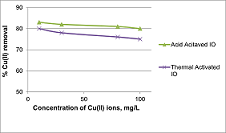Adsorptive Removal of Copper (II) Ions from Aqueous Solution using Acid and Thermally Activated Iron Oxide Sand

Abstract:
References:
[1] Aljamali,
Nagham & Jawad, Aseel & Alabbasy, Anaam & Salih, Layla &
Aljamali, Dr.Nagham & J, Aseel & M, Jawad & A, Nagham &
Mahmood, Aljamali. (2019). A Literature Review on Types of Contamination
(Biological, Chemical, Medical). International Journal of Green Chemistry,
Vol. 5, pp. 7-14.
[2] Tchounwou
PB, Yedjou CG, Patlolla AK, Sutton DJ. 2012, Heavy Metals Toxicity and the
Environment. Experientia supplementum (EXS, Vol. 101, pp. 133-164.
[3] Ma. del
Rosario Moreno Virgen, Omar Francisco González Vázquez, Virginia Hernández Montoya,
and Rigoberto Tovar Gómez., 2018, ‘Removal of Heavy Metals Using Adsorption
Processes Subject to an External Magnetic Field’, in H. E. M. Saleh, R. F.
Aglan (eds.), Heavy Metals, IntechOpen, London. 10.5772/intechopen.74050.
[4] Akbal,
F. and Camci, 2011, Copper, chromium, and nickel removal from metal plating
wastewater by Desalination. Desalination, Vol. 269, pp. 214-2221.
[5] Mohsen-Nia,
M., Montazeri, P. and Modarress, H, 2007, Removal of Cu2+ and Ni2+ from
wastewater with a chelating agent and reverse osmosis processes. Desalination,
Vol. 217, pp. 276-281.
[6] Rahmanian,
Bashir & Pakizeh, Majid & Esfandyari, Morteza & Heshmatnezhad,
Fazlollah & Maskooki, Abdolmajid. (2011). Fuzzy modeling and simulation for
lead removal using micellar-enhanced ultrafiltration (MEUF). Journal of
hazardous materials. 192. 585-92. 10.1016/j.jhazmat.2011.05.051.
[7] Lertlapwasin,
Ratthaya & Bhawawet, Nakara & Imyim, Apichat & Fuangswasdi,
Saowarux. (2010). Ionic liquid extraction of heavy metal ion by
2-aminothiophenol in 1-butyl-3-methylimidazolium hexafluorophosphate and their
association constants. Separation and Purification Technology. 72. 70–76.
10.1016/j.seppur.2010.01.004.
[8] Wang,
X and Li, Y, 2011, Measurement of Cu and Zn adsorption onto surficial sediment
components: new evidence for less importance of clay minerals. J Hazard Mater,
Vol. 189, pp. 719-723.
[9] Bajda,
T. and Klapyta, K., 2013, Adsorption of chromate from aqueous solutions by
HDTMA-modified clinoptilolite, glauconite and montmorillonite. Appl Clay Sci,
Vol. 86, pp. 169-173.
[10] Hegazi,
H., 2013, Removal of heavy metals from wastewater using agricultural and
industrial wastes as adsorbents. HBRC Journal, Vol. 9, pp. 276-282.
[11] Clive,
Mitchel. 2000. Industrial Mineral Resources of Zambia.
[12] Haidong,
Hu and Ke, Xu. 2020, High-Risk Pollutants in Wastewater, Elsevier, pp. 169-207.
[13] Ugwu,
I. M and Igbokwe, O. 2019, Sorption of Heavy Metals on Clay Minerals and
Oxides: A Review. In: Advanced Sorption Process Applications. pp. 1-4.
[14] Phenny
Mwaanga, Mathews Silondwa, George Kasali, Paul M. Banda, 2019, Preliminary
review of mine air pollution in Zambia. Heliyon.5(9).
[15] Mudenda,
Lee. 2018. Assessment of Water pollution arising from copper mining in Zambia:
a case study of Munkulungwe stream in Ndola, Copperbelt province. Cape Town:
University of Cape Town (UCT).
[16] Ikenaka,
Yoshinori & Nakayama, Shouta & Muzandu, Kaampwe & Choongo, Kennedy
& Teraoka, Hiroki & Mizuno, Naoharu & Ishizuka, Mayumi. (2010).
Heavy Metal Contamination of Soil and Sediment in Zambia. African Journal of
Environmental Science and Technology. 4. 729-739.
10.4314/ajest.v4i11.71339.
[17] Obayomia,
K and Autab, M. 11, 2019, Development of microporous activated Aloji clay for
adsorption of lead (II) ion from aqueous solution. Heliyon, Vol. 5, pp. 27-99.
[18] Univeristy,
James Cook. Element-to-stoichiometric oxide conversion factors. [Online] 2020.
[Cited: April 3, 2021.] t: https://www.jcu.edu.au/advanced-analytical-centre/resources/element-to-stoichiometric-oxideconversion-factors.
[19] Krachler,
Michael & Mohl, Carola & Emons, Hendrik & Shotyk, William. (2002).
Influence of digestion procedures on the determination of rare earth elements
in peat and plant samples by USN-ICP-MS. Journal of Analytical Atomic
Spectrometry. 17. 10.1039/B200780K.
[20] Novikova,
L., Belchinskaya, L., 2016, ‘Adsorption of Industrial Pollutants by Natural and
Modified Aluminosilicates’, in G. M. d. Nascimento (ed.), Clays, Clay Minerals
and Ceramic Materials Based on Clay Minerals, Intech Open, London.
10.5772/61678.
[21] Ahmed
Z. Khalifa, Özlem Cizer, Yiannis Pontikes, Andrew Heath, Pascaline Patureau,
Susan A. Bernal, Alastair T.M. Marsh, 2020, Advances in alkali-activation of
clay minerals. Advances in alkali-activation of clay minerals, Vol. 132, ISSN
0008-8846.
[22] Shuang
Xie, Zhang Wen, Hongbin Zhan, Menggui Jin.2018, An Experimental Study on the
Adsorption and Desorption of Cu (II) in Silty Clay. Geofluids, Vol. 4, pp.
1-12.
[23] Alandis,
N. & Mekhamer, Waffa & Aldayel, Omar & Hefne, Jameel & Alam,
Manawwer. (2019). Adsorptive Applications of Montmorillonite Clay for the
Removal of Ag(I) and Cu (II) from Aqueous Medium. Journal of Chemistry. 2019.
1-7. 10.1155/2019/7129014.
[24] Abbar,
Bouamama & Alem, Abdellah & Marcotte, Stéphane & Anne, Pantet &
Ahfir, Nasre-Dine & Bizet, Laurent & Duriatti, Davy. (2017).
Experimental investigation on removal of heavy metals (Cu 2+, Pb 2+, and Zn 2+)
from aqueous solution by flax fibres. Process Safety and Environmental
Protection. 109. 10.1016/j.psep.2017.05.012.

